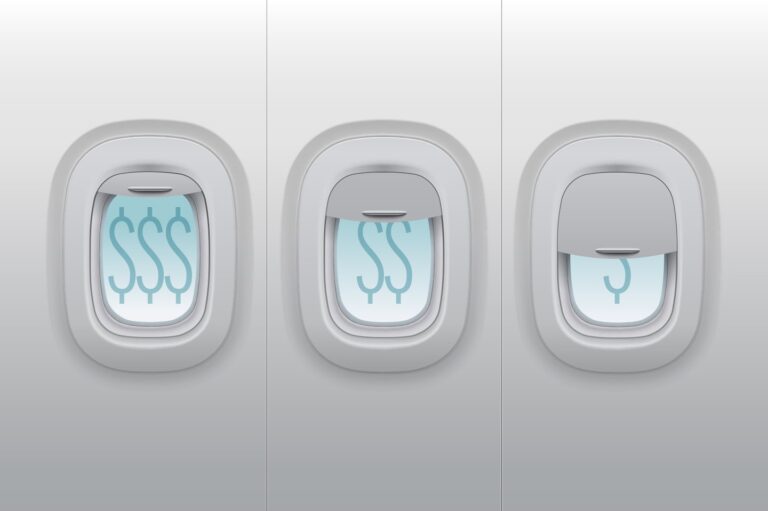For those unfamiliar with the airline’s longstanding seating policy, passengers are not assigned seats – they are provided on a first-come, first-served basis, making it unusual among major airlines.
For 50 years, the Southwest Airlines system has been a good example of how fair treatment works, for the most part.
I fly Southwest often, and one thing that stood out about their boarding process was that price-sensitive passengers were treated essentially the same. Sure, the coveted bulkhead and exit aisle seats fill up quickly, but pretty much every other seat is the same size.
Everyone can check in up to two bags for free, and with your boarding number you won’t have to crowd around the gate and compete to be one of the first to board.
Southwest has a few perks.
“Business Select” passengers do not get special seats at the front of the aircraft. They get priority boarding (after passengers who require assistance). In addition, there is “Early Bird Check-in”. For a fee, these passengers will be automatically checked in and also benefit from an earlier boarding position. This increases the chances of getting the seat of their choice and overhead bin space.
But when you check in, you won’t have to walk past first- or business-class passengers sitting in enviable seats sipping drinks delivered to them on trays and hoping there’s still overhead space for their carry-on bags.
At Southwest, there is no curtain separating the haves and have-nots, either physically or psychologically.
Southwest plans to install extra legroom seats in roughly a third of its fleet under the new policy, with the new configurations set to become available in 2025.
Southwest said its survey showed many customers had a strong preference for premium seating options.
“Our unique open-seating model has been a part of Southwest since our founding, but our thoughtful and extensive research made it clear this was the right choice at the right time for our customers, employees and shareholders,” Southwest Airlines President and CEO Bob Jordan said in a statement.
No doubt many people would be willing to pay for comfort, and with increasing wealth people can always buy a better status in life or on an airline.
“Wealth inequality in the United States is high compared to other developed countries and has been rising for most of the past 60 years,” the April report said. report By the Urban Institute.
In 1963, the wealthiest families had 36 times the wealth of the middle class. By 2022, that amount had jumped to 71 times the wealth of the middle class. The wealth of families richer than 99% of all families increased more than sevenfold, from $1.8 million to $13.6 million.
Economic inequality for ethnic minorities is even worse, the result of “the long-term effects of racist policies, not individual intentions or shortcomings,” the report said.
The median wealth of white households was $1.4 million in 2022, compared to $211,596 and $227,544 for black and Hispanic households, respectively.
“In a country that proclaims that those who work hard and follow the rules should be rewarded with social and economic advancement, these persistent disparities are a stark reminder that as a society we are falling short of this goal,” the report said.
Southwest’s move also signals shareholder expectations.
Solid profits alone are not enough, because companies must feed the monster that is Wall Street.
Despite recent market turmoil, investors are generally in good spirits: The Dow Jones Industrial Average, S&P 500 and Nasdaq all hit record highs in July.
But these demands come at a cost: As companies strive to make bigger profits quarter after quarter and year after year, prices inevitably fall for many consumers.
The middle class is shrinking, as is legroom and seat width on many airlines: Most Americans can no longer afford a college education, a home, or a car.
a report A Pew Research Center study released earlier this year found that the percentage of adults in the middle class is expected to fall from 61% in 1971 to 51% in 2023.
The Pew Research Center reported that the median income of middle-class families increased from about $66,400 in 1970 to $106,100 in 2022. During this period, the median income of high-income families increased from about $144,100 to $256,900.
Some may argue that it’s fair for those with money to buy the upgrades they want, but we can’t ignore the impact economic inequality has on society.
People fight over what’s left.
Continuing with the airline example, passengers are fighting over space in the luggage compartment, and when passengers recline their seats, it creates tension and increases discomfort for the passenger behind them.
A fairer aircraft cabin makes flying less stressful and more comfortable for everyone. Eliminating the gap between rich and poor creates a better world, allowing the wealthy to enjoy luxuries while low- and middle-income families can enjoy a better life.
Southwest Airlines’ CEO said on an earnings conference call that the airline has no plans to add a first-class department or end its free-baggage policy.
Jordan said airlines won’t install seats with doors or massage features, nor will they install ovens to cook hot meals for special passengers.
There are no curtains either.



